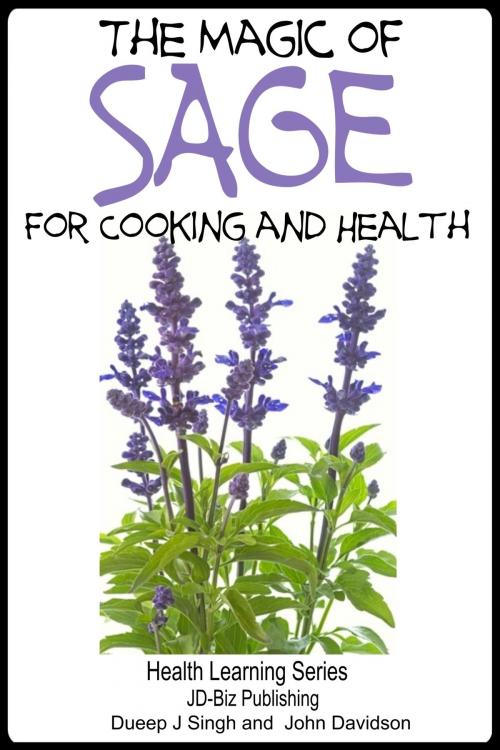The Magic of Sage For Cooking and Health
Nonfiction, Home & Garden, Gardening, Herbs, Food & Drink, Herbs & Spices| Author: | Dueep Jyot Singh, John Davidson | ISBN: | 9781311153357 |
| Publisher: | JD-Biz Corp Publishing | Publication: | July 30, 2014 |
| Imprint: | Smashwords Edition | Language: | English |
| Author: | Dueep Jyot Singh, John Davidson |
| ISBN: | 9781311153357 |
| Publisher: | JD-Biz Corp Publishing |
| Publication: | July 30, 2014 |
| Imprint: | Smashwords Edition |
| Language: | English |
The Magic of Sage For Cooking and Health
Table of Contents
Introduction
How to Grow Sage
Planting Sage
Taking Care of Sage
Pests Attacking Sage
Harvesting and Storing Your Sage Leaves
Sage as a Healer
Sage Tooth Care Remedy
Sage for Healing Cuts
Sage for Hair Treatment
Josna’s Rosemary and Sage Hair-Conditioner
Knowing More about Coconut Oil
Massage oil
How to make Infused Oils
The Slow Sun Method
How to Make Desi ghee (Clarified Butter) for Infusions
Quick kitchen Method:
Sage in Cuisine
Traditional Onion and Sage Sauce
Conclusion
Author Bio
Introduction
Just imagine that you are living in ancient times in the Mediterranean area. Naturally, you do not have access to state-of-the-art medicine. So you are going to be using nostrums, lotions, potions, concoctions, decoctions and other remedies handed down from your ancestors and which are supposed to heal all your ailments.
That means the next time you feel weak, exhausted, or just need something to perk you up, the woman of the house is going to feed you with Sage tea. After that, she is going to feed you delicious dishes flavored with this culinary magical herb.
Is it a wonder that Sage is one of the most popular of herbs, grown in our herbal gardens, with its lore of healing powers and culinary delights coming to us down the ages?
Sage, like a number of very popular cooking herbs originated from the Mediterranean, although it found a home in colder climates, where the frost was not so harsh.e a number of very popular cooking herbs originated from the Mediterranean, although it found a home in colder climates, where the frost was not so harsh. This worldwide conquering of the Sage is due to the fact that traders from the West took it all over the East, and so did the gypsies. The gypsies who are very well-versed in herbal lore used (and still use) Sage extensively to keep them healthy.
Apart from using Sage leaves to make their traditional delicious stuffings and sauces, Gypsy children were taught from a very young age to chew on Sage leaves. Not only did this keep their breath fresh, but also kept their mouth, chest, and throat infection free.
Sage has a strong taste and is generally used to flavor the richer meats such as duck, pork and goose. Rosemary and sage – both of them go together mixed with thyme, marjoram and other herbs.
In ancient times, sages – no pun intended – always advocated that people who were addicted to overeating, eat more Sage because this aided in the digestion of fats, and did not allow it to accumulate on your tummy, legs, hips and thighs.
So I would not be surprised that Romans having their parties and bacchanalias would not enjoy such delicacies as larks and peacocks stuffed with Sage, and also – ahummmm, ah well, – dormice sprinkled with poppy seeds, honey, and sage. All these recipes are authentic recipes, taken from an ancient Roman book on Roman cuisine, during the times of Pompeii and Herculaneum.
Since then, is it a surprise that for centuries Sage has been highly regarded as a delicious flavoring addition to your cuisine, as well as in medicine, as shown by a traditional saying, “why should a man die while Sage grows in his garden?” That is because it was considered to be a cure-all for a large number of ailments, from which mankind suffered periodically.
It was also said that any person growing Sage in his garden would never fail in business. Well, there is some justification here. Plenty of Sage in his food, and he would be working with a clear head, enhanced concentration,
The Latin name of sage is Salvia officinalis. The Sage that we use in cuisine is often dried or used fresh, like other members of the Labiateae family like mint. It is cultivated extensively in Yugoslavia, England, Spain, Portugal, Cyprus, England and the USA and Canada.
The Magic of Sage For Cooking and Health
Table of Contents
Introduction
How to Grow Sage
Planting Sage
Taking Care of Sage
Pests Attacking Sage
Harvesting and Storing Your Sage Leaves
Sage as a Healer
Sage Tooth Care Remedy
Sage for Healing Cuts
Sage for Hair Treatment
Josna’s Rosemary and Sage Hair-Conditioner
Knowing More about Coconut Oil
Massage oil
How to make Infused Oils
The Slow Sun Method
How to Make Desi ghee (Clarified Butter) for Infusions
Quick kitchen Method:
Sage in Cuisine
Traditional Onion and Sage Sauce
Conclusion
Author Bio
Introduction
Just imagine that you are living in ancient times in the Mediterranean area. Naturally, you do not have access to state-of-the-art medicine. So you are going to be using nostrums, lotions, potions, concoctions, decoctions and other remedies handed down from your ancestors and which are supposed to heal all your ailments.
That means the next time you feel weak, exhausted, or just need something to perk you up, the woman of the house is going to feed you with Sage tea. After that, she is going to feed you delicious dishes flavored with this culinary magical herb.
Is it a wonder that Sage is one of the most popular of herbs, grown in our herbal gardens, with its lore of healing powers and culinary delights coming to us down the ages?
Sage, like a number of very popular cooking herbs originated from the Mediterranean, although it found a home in colder climates, where the frost was not so harsh.e a number of very popular cooking herbs originated from the Mediterranean, although it found a home in colder climates, where the frost was not so harsh. This worldwide conquering of the Sage is due to the fact that traders from the West took it all over the East, and so did the gypsies. The gypsies who are very well-versed in herbal lore used (and still use) Sage extensively to keep them healthy.
Apart from using Sage leaves to make their traditional delicious stuffings and sauces, Gypsy children were taught from a very young age to chew on Sage leaves. Not only did this keep their breath fresh, but also kept their mouth, chest, and throat infection free.
Sage has a strong taste and is generally used to flavor the richer meats such as duck, pork and goose. Rosemary and sage – both of them go together mixed with thyme, marjoram and other herbs.
In ancient times, sages – no pun intended – always advocated that people who were addicted to overeating, eat more Sage because this aided in the digestion of fats, and did not allow it to accumulate on your tummy, legs, hips and thighs.
So I would not be surprised that Romans having their parties and bacchanalias would not enjoy such delicacies as larks and peacocks stuffed with Sage, and also – ahummmm, ah well, – dormice sprinkled with poppy seeds, honey, and sage. All these recipes are authentic recipes, taken from an ancient Roman book on Roman cuisine, during the times of Pompeii and Herculaneum.
Since then, is it a surprise that for centuries Sage has been highly regarded as a delicious flavoring addition to your cuisine, as well as in medicine, as shown by a traditional saying, “why should a man die while Sage grows in his garden?” That is because it was considered to be a cure-all for a large number of ailments, from which mankind suffered periodically.
It was also said that any person growing Sage in his garden would never fail in business. Well, there is some justification here. Plenty of Sage in his food, and he would be working with a clear head, enhanced concentration,
The Latin name of sage is Salvia officinalis. The Sage that we use in cuisine is often dried or used fresh, like other members of the Labiateae family like mint. It is cultivated extensively in Yugoslavia, England, Spain, Portugal, Cyprus, England and the USA and Canada.















